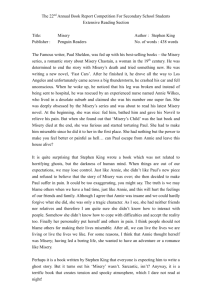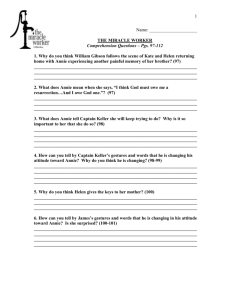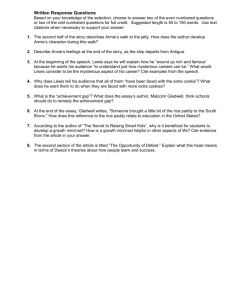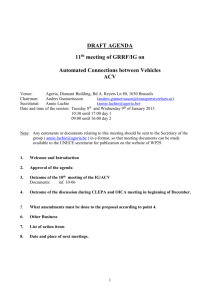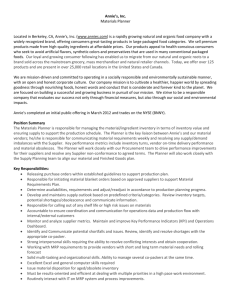Misery - englit.org
advertisement
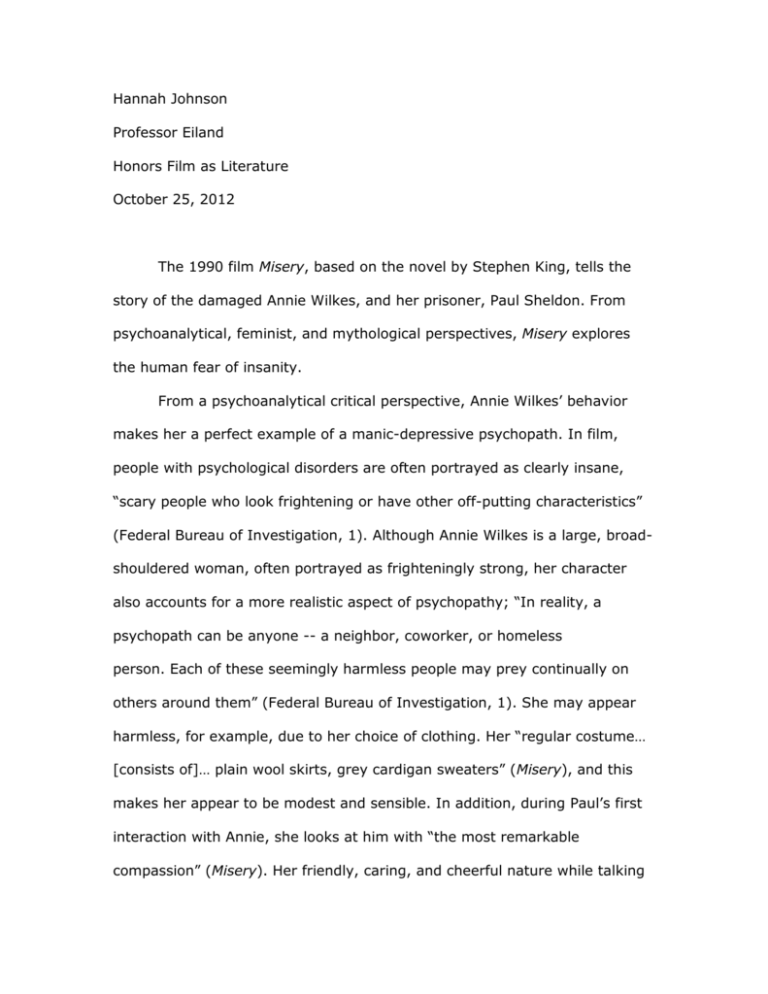
Hannah Johnson Professor Eiland Honors Film as Literature October 25, 2012 The 1990 film Misery, based on the novel by Stephen King, tells the story of the damaged Annie Wilkes, and her prisoner, Paul Sheldon. From psychoanalytical, feminist, and mythological perspectives, Misery explores the human fear of insanity. From a psychoanalytical critical perspective, Annie Wilkes’ behavior makes her a perfect example of a manic-depressive psychopath. In film, people with psychological disorders are often portrayed as clearly insane, “scary people who look frightening or have other off-putting characteristics” (Federal Bureau of Investigation, 1). Although Annie Wilkes is a large, broadshouldered woman, often portrayed as frighteningly strong, her character also accounts for a more realistic aspect of psychopathy; “In reality, a psychopath can be anyone -- a neighbor, coworker, or homeless person. Each of these seemingly harmless people may prey continually on others around them” (Federal Bureau of Investigation, 1). She may appear harmless, for example, due to her choice of clothing. Her “regular costume… [consists of]… plain wool skirts, grey cardigan sweaters” (Misery), and this makes her appear to be modest and sensible. In addition, during Paul’s first interaction with Annie, she looks at him with “the most remarkable compassion” (Misery). Her friendly, caring, and cheerful nature while talking Johnson 2 with Paul for the first time displays another trait of the typical psychopath: “most psychopaths can present themselves favorably on a first impression” (Federal Bureau of Investigation, 1). This is supported by the fact that “Many psychopaths have little difficulty joining the ranks of business, politics, law enforcement, government, and academia” and “exist in all lines of work” (Federal Bureau of Investigation, 1). Paul eventually reads newspaper headlines about Annie, including “MISS WILKES IS NURSING SCHOOL HONORS GRADUATE” and “NEW HEAD MATERNITY NURSE NAMED” (Misery). Throughout her life, Annie evidently had no trouble fooling society into believing that she was a hardworking, dedicated, caring individual capable of being a nurse. Her murders along the way were left undiscovered because she fabricated a sort of false identity for herself, and the people around her were convinced enough to trust her. Like Annie, many psychopaths are “glib and charming, and they use these attributes to manipulate others into trusting and believing in them,” making psychopathy “the most dangerous of the personality disorders” (Federal Bureau of Investigation, 1). According to the newspaper articles Paul discovers, Annie has killed numerous people, including several babies, but she has continued on with her life and does not seem to feel any guilt over the matter. Instead, she puts the newspaper articles in a book as if she thinks of her murders as accomplishments, an example of her desire for her life to be important and dramatic, regardless of the cost to others. Annie’s criminal behavior matches up perfectly with that of the typical psychopath; “many psychopaths exhibit a profound lack of remorse for their aggressive actions, both violent and nonviolent, along with Johnson 3 a corresponding lack of empathy for their victims” (Federal Bureau of Investigation, 1). She keeps the newspaper articles as a sort of shrine to herself, demonstrating her grandiosity and her desire to be involved in sensational drama. This type of delusional grandiosity is typical of psychopaths, who are often “grandiose, selfish sensation seekers” (Federal Bureau of Investigation, 1). In addition, psychopaths tend to “act in a coldblooded manner, using those around them as pawns to achieve goals and satisfy needs and desires, whether sexual, financial, physical, or emotional” (Federal Bureau of Investigation, 1). Annie uses Paul as a pawn, kidnapping him and forcing him to write another Misery novel, all to satisfy her personal need to see her favorite fictional character resurrected. Another trait typical of psychopaths is that they “do not accept responsibility for their actions and find a way to shift the blame to someone or something else” (Federal Bureau of Investigation, 1). Annie does this when she becomes upset with Paul and ends up spilling some soup. Her initial response is to blame him, saying “‘There! Look there! See what you made me do!’” (Misery), even though the spill was really her fault. When she becomes aware of her behavior, she quickly attempts to cover up the incident, putting on “the sweetest smile” and saying, “‘Oh, Paul, I'm sorry. I'm so sorry. Sometimes I get so worked up. Can you ever forgive me?’” (Misery). Psychopaths “frequently will claim they lost control or were in a rage when committing the act of violence” (Federal Bureau of Investigation, 1), such as Annie does when she claims she was just “’worked up’” (Misery). Annie also displays symptoms of manicdepression, or bipolar disorder, which is characterized by “alternating periods Johnson 4 of mania (excessive elation or manic excitement) and the profound sadness of depression” (Zimbardo, et. al., 544). In a manic state, it is common for the person to be “talking very fast, jumping from one idea to another and having racing thoughts” (U.S. Department of Health and Human Services, 1). Paul comes into contact with manic Annie most frequently. In this state, she is smiling, talking quickly, appears generally overexcited, and has no filter on what she says, like when she tells Paul she loves him (Misery). On the other hand, in a depressive state, the person is likely to be “feeling tired or slowed down" and “thinking of death or suicide” (U.S. Department of Health and Human Services, 1). In the depressive portion of her manic-depressive cycle, she comes “lumbering in … wearing her slippers and her pink quilted housecoat. Her eyes are without life. Her hair, loose and straggly, hangs around her face” (Misery). Annie displays her suicidal ideation when she says “’I have this gun, and sometimes I think about using it’” (Misery). Her desire for herself and Paul to commit suicide together reflects both the depressive part of her bipolar disorder and her psychopathy. She has a strong desire to commit suicide in a dramatic way that will bring attention to her life, and to achieve this she needs to take Paul down with her because she is aware on some level that her death would not be of much importance to the rest of the world, whereas the death of a famous writer would produce the drama she craves. And like most psychopaths, who “go through life taking what they want” (Federal Bureau of Investigation, 1), she does not care who or what she has to destroy to satisfy her needs. Johnson 5 From a feminist critical perspective, Annie Wilkes is portrayed as powerful on a superficial level, but ultimately displays traits of the stereotypical female who can be controlled by men. Annie is “one of [Stephen] King’s first attempts to create a fiercely independent woman” (Magistrale, 62), a character who holds a godlike amount of power over the protagonist and “is not only Paul’s jailer, but also his sole connection to the rest of the world” (Magistrale, 63). Rather than retelling the stereotypical story of a male captor and a female victim, Misery may provide feminists with “some degree of poetic justice in [the film’s] role reversal” (Magistrale, 66). On the surface, feminists might appreciate Annie’s role as the dominant female, but she displays behavior that conflicts with the feminist school of thought. As an avid reader of romance novels, Annie fulfills a stereotype by “accepting the general structure of patriarchy” (Burnett & Beto, 1) in works of romantic fiction, which “scholars argue… reflect and reinforce a patriarchal society” and promote “definitions of women as deriving their happiness only through men” (Burnett & Beto, 1). In much of modern film “women are manipulated to support the current understanding of the limited gender roles that are set by male society and that are supported by cultural norms and practices” (LeClair, 1), just as Annie is romantically manipulated by Paul in Misery. Paul flatters her with compliments, referring to her as his “’favorite nurse’” (Misery), and asking her to have dinner with him. Annie’s susceptibility to Paul’s insincere romance distracts her and makes her vulnerable; Paul’s plan to poison her relies on the fact that he can easily flatter her and make her lose her focus. Paul also reassures himself of his Johnson 6 masculinity by calling Annie a “’crazy bitch’” (Misery). The use of the word “bitch” has sexist implications, “a word we use culturally to describe any woman who is strong, angry, uncompromising and, often, uninterested in pleasing men” (Zeisler, 1), often used by “across-the-board woman-haters” (Zeisler, 1). From a feminist perspective, Paul is using the word to compensate for the fact that he is being held captive by a woman because saying the word “bitch” is “simply another way to denigrate women” (Zeisler, 1), something that Misery manages to do regardless of Stephen King’s original intentions. From a mythological critical perspective, the characters in Misery are consistent with literary archetypes. In mythology, the monster is “hostile to people” and tends to “inspire dread and embody evil” ("Archetypes”, 10). Annie Wilkes is the archetypal monster, and her character is filmed to reflect that. Annie’s face is often filmed “in an upward diagonal angle” (Magistrale, 66), and close ups of her face are usually accompanied by shadows, such as the scene in which she reprimands Paul for his cursing, when “half of her face disappears into the dark shadows that fill the bedroom” (Magistrale, 66). This shadowy scene is a signal that Annie is “a version of the Gothic villainmonster” (Magistrale, 65); her character is presented in such a way that the audience immediately knows to fear her. Paul is the archetypal hero, on a quest to escape from Annie’s grasp and restore his passion for writing. The hero “may search for… knowledge for himself” (Wood, 2), just as Paul searches for knowledge and strength as a writer. Paul cannot defeat Annie by himself; he needs the help of the talisman, which is his writing. Paul “learns Johnson 7 that his survival is linked to his writing: as long as he can keep Annie interested in the evolving narrative, she will keep him alive” (Magistrale, 64), meaning that his writing is the only part of himself that can keep death at bay. The hero often “struggles for something valuable and important” and “goes through a rite of passage or initiation” (“Archetypes”, 6), and the writer in Paul grows and evolves, enduring the wrath of Annie Wilkes, “the reader-response critic pushed to its ultimate extreme” (Magistrale, 65) and ultimately saving his life, just as the talisman helps the archetypal hero complete his quest. Although his quest is over when he kills Annie and finishes the new Misery novel, Paul, like many archetypal heroes, is permanently changed by his traumatizing time with Annie; “once the questing hero has faced his or her trials successfully, they return to their people, usually transformed by their experience” (Wood, 3). At the end of the film, when his agent says, “’I thought you were over it,’” Paul replies, “’I am. Well, maybe not completely… I don't know if you can ever be totally over something like that’” (Misery). Paul has completed his quest with the help of his talisman, and he has been fundamentally changed by his encounter with the monster. From psychoanalytical, feminist, and mythological perspectives, Misery explores the human fear of insanity. The character of Annie Wilkes reveals that sometimes the most terrifying monsters are living among us. Johnson 8 Works Cited "Archetypes." WTPS.org. Washington Township Public School District, 1 Feb. 2009. Web. 2 Oct. 2012. Burnett, Ann, and Rhea R. Beto. "Reading Romance Novels: An Application of Parasocial Relationship Theory." Education Technology Services. The North Dakota Journal of Speech & Theatre, n.d. Web. 24 Oct. 2012. LeClair, Melissa P. "The Princess Diaries: An Interpretation of a Cultural Product Via the Media." University of Central Florida. Pegasus, 09 June 2011. Web. 24 Oct 2012. Magistrale, Tony. "Maternal Archetypes: Cujo, Misery, Dolores Claiborne." Hollywood's Stephen King. New York: Palgrave Macmillan, 2003. 62-71. Google Books. Web. 2 Oct. 2012. "Manic Depression/Bipolar Disorder." Johns Hopkins Medicine, Based in Baltimore, Maryland. Johns Hopkins University. Web. 02 Oct. 2012. Misery. Dir. Rob Reiner. Screenplay by William Goldman. By Stephen King. Prod. Rob Reiner, Andrew Scheinman, Jeffrey Stott, and Steve Nicolaides. Perf. James Caan and Kathy Bates. Castle Rock Entertainment, 1990. Transcript. U.S. Department of Health and Human Services. The National Institute of Mental Health. Bipolar Disorder. National Institute of Mental Health, 2008. The National Institute of Mental Health. U.S. Department of Health and Human Services, 2008. Web. 23 Sept. 2012. U.S. Department of Justice. Federal Bureau of Investigation. Law Enforcement Bulletin: Psychopathy. By Paul Babiak, Jorge Folino, Jeffrey Hancock, Robert D. Hare, Matthew Logan, J. Reid Meloy, Elizabeth Leon Mayer, Helinä Häkkänen-Nyholm, Mary Ellen O’Toole, Anthony Pinizzotto, Stephen Porter, Sharon Smith, and Michael Woodworth. FBI, July 2012. Web. 23 Sept. 2012. Wood, Michael. "In Search of Myths and Heroes." PBS. Educational Broadcasting Corporation, Nov. 2005. Web. 11 Oct. 2012. Zeisler, Andi. "The B-Word? You Betcha." Washington Post. The Washington Post Company, 18 Nov. 2007. Web. 02 Oct. 2012. Zimbardo, Philip G., Robert L. Johnson, and Vivian McCann. "Psychological Disorders." 2009. Psychology: Core Concepts. 6th ed. Boston: Pearson/Allyn and Bacon, 2009. 551-53. Print.


